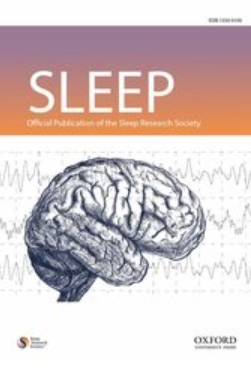Expiratory Muscle Strength Training Reduces Oxidative Stress and Systemic Inflammation in Men with Obstructive Sleep Apnea Syndrome: A Double-Blinded, Randomized Parallel Trial
IF 5.6
2区 医学
Q1 Medicine
引用次数: 0
Abstract
Study Objectives This study aimed to evaluate and compare the effects of high and low-intensity expiratory muscle strength training (EMST) on disease severity, systemic inflammation, oxidative stress, respiratory muscle strength, exercise capacity, symptoms, daytime sleepiness, fatigue severity, and sleep quality in male patients with obstructive sleep apnea syndrome (OSAS). Methods Thirty-one male patients diagnosed with moderate OSAS were included in this double-blind, randomized, parallel study. Patients were randomized into two groups: High-EMST and Low-EMST groups. EMST was used at home 7 days/week, once a day, for 25 breaths, 12 weeks. Respiratory muscle strength was measured using a mouth pressure device. Disease severity (Apne Hipopne Index-AHI) and, respiratory sleep events by polysomnography, total oxidant level(TOS), total antioxidant level(TAS), oxidative stress index (OSI), C-reactive protein (CRP), tumor necrosis factor-alpha (TNF-α), interleukin-6 (IL-6), and interleukin-10 (IL-10) levels by blood serum were evaluated. Results The percentage of AHI change in the High-EMST group(50.8%) was significantly higher than in the Low-EMST group(6.3%) (p=0.002, d=1.31). In general, as MEP increased by one unit, AHI decreased by 0.149 points (b=-0.149; CR=-3.065; p=0.002), and as AHI increased by one unit, ODI increased by 0.746 points (b=0.746; CR=10.604; p<0.001). TOS, OSI, TNF-α and IL-6 levels decreased at similar rates in both groups. Conclusion EMST significantly reduces systemic inflammation and oxidative stress while improving expiratory muscle strength in male patients with moderate OSAS. High-EMST is more effective in enhancing the severity of disease than Low-EMST. EMST is a practical, effective, and promising treatment for pulmonary rehabilitation in patients with moderate OSAS.呼气肌力量训练可降低阻塞性睡眠呼吸暂停综合征男性患者的氧化应激和全身炎症:双盲随机平行试验
研究目的 本研究旨在评估和比较高强度和低强度呼气肌肉力量训练(EMST)对阻塞性睡眠呼吸暂停综合征(OSAS)男性患者的疾病严重程度、全身炎症、氧化应激、呼吸肌力量、运动能力、症状、白天嗜睡、疲劳严重程度和睡眠质量的影响。方法 这项双盲、随机、平行研究纳入了 31 名确诊为中度阻塞性睡眠呼吸暂停综合症的男性患者。患者被随机分为两组:高EMST组和低EMST组。每周 7 天在家使用 EMST,每天一次,每次 25 次呼吸,持续 12 周。使用口压装置测量呼吸肌强度。通过多导睡眠图评估疾病严重程度(Apne Hipopne Index-AHI)和呼吸睡眠事件,通过血清评估总氧化剂水平(TOS)、总抗氧化剂水平(TAS)、氧化应激指数(OSI)、C反应蛋白(CRP)、肿瘤坏死因子-α(TNF-α)、白细胞介素-6(IL-6)和白细胞介素-10(IL-10)水平。结果 高EMST组的AHI变化百分比(50.8%)明显高于低EMST组(6.3%)(P=0.002,d=1.31)。一般来说,MEP 增加一个单位,AHI 降低 0.149 点(b=-0.149;CR=-3.065;p=0.002);AHI 增加一个单位,ODI 增加 0.746 点(b=0.746;CR=10.604;p<0.001)。两组的 TOS、OSI、TNF-α 和 IL-6 水平下降率相似。结论 EMST能明显减轻中度OSAS男性患者的全身炎症和氧化应激,同时改善呼气肌力。与低EMST相比,高EMST能更有效地减轻疾病的严重程度。在中度 OSAS 患者的肺康复治疗中,EMST 是一种实用、有效且前景广阔的治疗方法。
本文章由计算机程序翻译,如有差异,请以英文原文为准。
求助全文
约1分钟内获得全文
求助全文
来源期刊

Sleep
Medicine-Neurology (clinical)
CiteScore
8.70
自引率
10.70%
发文量
0
期刊介绍:
SLEEP® publishes findings from studies conducted at any level of analysis, including:
Genes
Molecules
Cells
Physiology
Neural systems and circuits
Behavior and cognition
Self-report
SLEEP® publishes articles that use a wide variety of scientific approaches and address a broad range of topics. These may include, but are not limited to:
Basic and neuroscience studies of sleep and circadian mechanisms
In vitro and animal models of sleep, circadian rhythms, and human disorders
Pre-clinical human investigations, including the measurement and manipulation of sleep and circadian rhythms
Studies in clinical or population samples. These may address factors influencing sleep and circadian rhythms (e.g., development and aging, and social and environmental influences) and relationships between sleep, circadian rhythms, health, and disease
Clinical trials, epidemiology studies, implementation, and dissemination research.
 求助内容:
求助内容: 应助结果提醒方式:
应助结果提醒方式:


